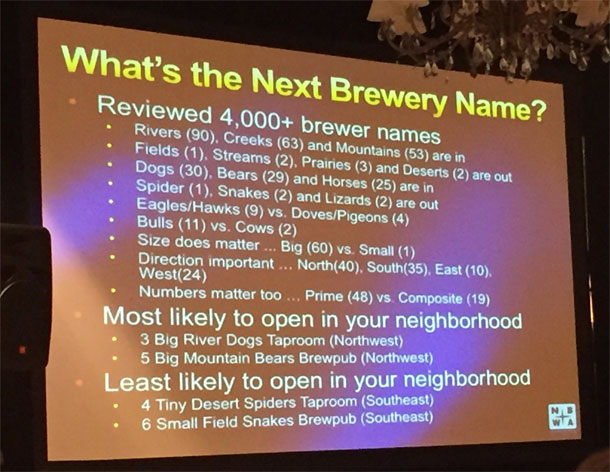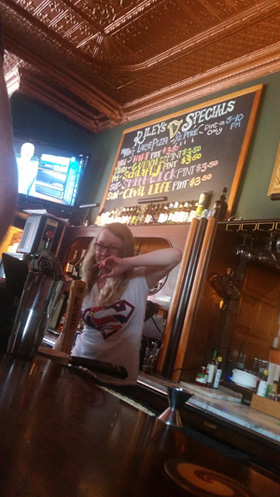MONDAY BEER LINKS, MUSING, 07.11.16
Hopportunity Cost: Craft Brewers Brawl Over Catchy Names as Puns Run Dry.
Maybe, maybe not. But this story does present an opportunity to show this slide Lester Jones, NBWA economist, displayed during his presentation at the Beer Bloggers Conference in Tampa. Photo courtesy Sean Jansen. (Disclosure: As the keynote speaker I had my way to the conference paid.) [Via Wall Street Journal]

How Craft Brewers Advance Science, and Make Better Beer.
The blurb on Twitter that pointed me to this story mentioned hop genome sequencing (which Hopsteiner and others have been working for some time), so I headed there expecting something in the way of new information about that. Didn’t happen. So perhaps it is my disappointment typing, but to write Paul Mathews — who is scary smart — “is to hops what John James Audubon was to birds” is ludicrous. How hard would it have been to discover what E.S. Salmon accomplished a century ago? [Via The New Yorker]
Bits we Underlined In… How To Run a Pub, 1969.
This book “is a product of its time: it is addressed entirely to men, women are a problem to be dealt with, and the language around race might shock some modern readers.” Of course, that it offers such a candid look at its time is what makes it so interesting. [Via Boak & Bailey’s Beer Blog]
‘Heaven’s water’: the launch of Amsterdam’s first rainwater beer.
I feel like I should have known this: “It seems like a disruptive idea, but when we researched it, in the Middle Ages, [Dutch] breweries set up near churches and cathedrals to catch rainwater runoff from their roofs.” [Via The Guardian]
The Foundations of a Great American Brewery: The Early Architecture of Anheuser-Busch.
The first installment in what apparently will be several posts. For additional reading I recommend ordering a copy of Brewery History 155: “Approaches to the history of American brewery architecture.” [Via St. Louis Magazine]
Ich bin ein Berliner (Weisse) – A beery tour of Germany’s capital.
And more suggested additional reading: Joe Stange writes about Berlin in the current issue of DRAFT magazine (in print, no link). [Via Beeson on Beer, h/T Matthew Curtis]
This brewery is using cutting-edge Artificial Intelligence to engineer the perfect beer.
Not intended as a political statement, but were I to come up with a beer brewing algorithm I would not call it ABI. [Via Digital Trends]
FROM TWITTER
Yes, this is my tweet, but several of the responses were delightfully clever (click on the date to see them).
Tampa. Beer Bloggers conference. Write your own caption. #BBC16 pic.twitter.com/PAuGuw6kDP
— Stan Hieronymus (@StanHieronymus) July 8, 2016
 This is my contribution to this month’s Session,
This is my contribution to this month’s Session,  At 4:15, 15 minutes before the program would start, there were still seats at the bar. They quickly disappeared by the time the bartender poured a Zwickel, a Zwickel, a Harp, another Zwickel, opened the Guinness tap, slid a can of 4 Hands City Wide across the bar and filled two glasses of water before returning finish the Guinness pour.
At 4:15, 15 minutes before the program would start, there were still seats at the bar. They quickly disappeared by the time the bartender poured a Zwickel, a Zwickel, a Harp, another Zwickel, opened the Guinness tap, slid a can of 4 Hands City Wide across the bar and filled two glasses of water before returning finish the Guinness pour.